5 reasons why the RBA will hike next week (and the key reason it may not)
The Australian economics community has been more or less split between whether the Reserve Bank will hike one more time or whether its hiking cycle is done for good. That split came to a crashing halt last week when the Q3 inflation print hit the wires.
The upside surprise was also enough for rates markets to sit up and increase their expectations for a hike from 5% to 55% on Melbourne Cup day.
Morgan Stanley, which has had a 4.35% terminal rate call for some time, recently released the main reasons for why it continues to expect a rate hike next week when other economists had not considered it their highest conviction call previously. Along with each reason, they also provided a chart which explains their base case.
In this wire, I'll show you all those reasons with their accompanying charts. We'll also probe two reasons why the RBA may not choose to hike next week. Either way, there are some big implications for investors and now is the time to prepare for the outcome.
Public enemy and reason number 1: Inflation
Inflation clocked in at 5.4% on a headline, year-over-year basis and 5.2% on a trimmed mean, year-over-year basis. That figure is not only more than double the RBA's target midpoint, it's also higher than the RBA's own expectations. The RBA's economists project inflation will be at 4.25% on a headline basis and 4% on a trimmed mean basis by the end of the year.
And while everything is relative, the ongoing crises in Ukraine and the Middle East, soaring rents, and ongoing issues with labour productivity imply a 1.2% fall in year-over-year inflation is an extremely tough ask.
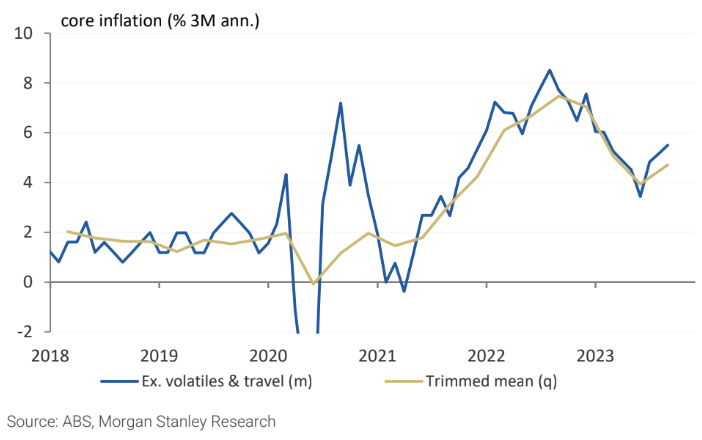
As Australia economist and equity strategist Chris Read put it:
"Disinflationary trends are stalling at still-uncomfortable levels and animal spirits in the economy suggest behaviour has embraced the current pause as a peak in rates with potential to ease.
Our view is a another hike will have a meaningful impact in reversing recent trends and regaining credibility of policy targets," he wrote.
And speaking of inflation, the RBA has mentioned time and time again how important it is for medium and long-term inflation expectations to remain "well-anchored". That is, high inflation cannot be entrenched in the psychology of consumers or that will be a big hindrance in the RBA's fight against it.
Unfortunately for the central bank, it appears that it's not only losing the war - it's losing it at a rate not seen for a decade.
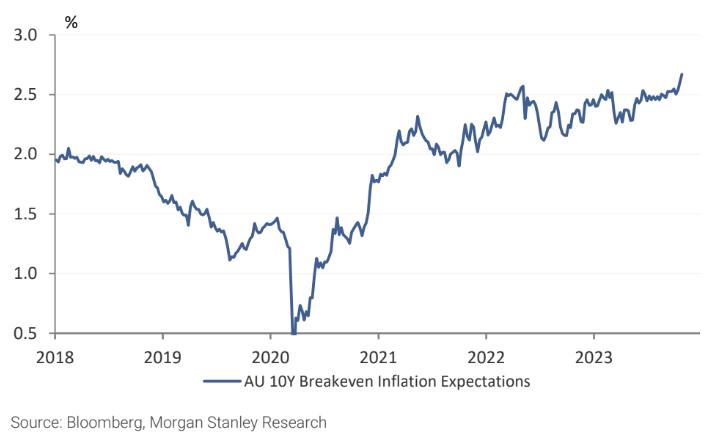
Reason 2: The labour market remains remarkably strong
Put simply, every indicator of the Australian job market continues to trend in a direction that makes the RBA's life much more difficult. Unemployment is low, wage pressures are broadening, and lower productivity in the aftermath of the COVID-19 pandemic is making the inflationary impact of wage increases worse.
Employment intentions and job advertisements are barely up
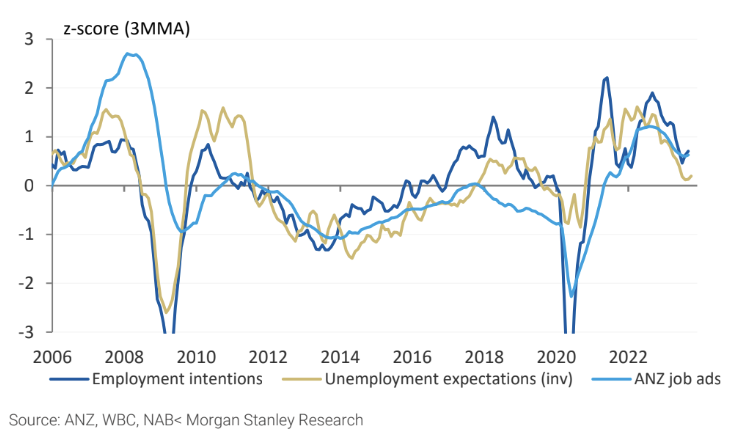
The impact of wage increases is showing up in inflation
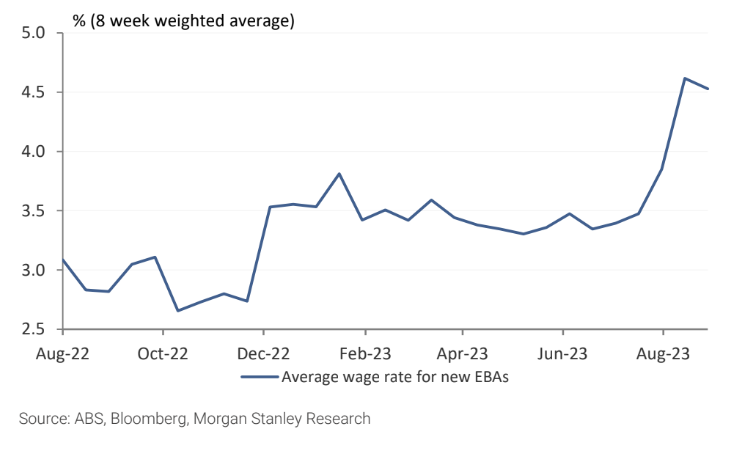
And the rate of productivity, measured as GDP generated per hour worked is declining
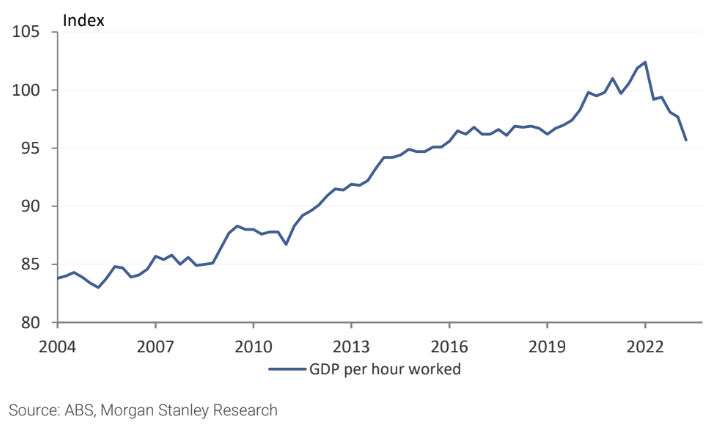
Reason 3: Business conditions remain robust
A rise in interest rates would normally curb business spending intentions, given it would cost more to take out and service the loans needed to carry out those investments. But above-trend growth in business conditions (signified by a rise in new orders and resilience in existing orders) suggests businesses are coping better than expected despite the 400 basis points in rate hikes.
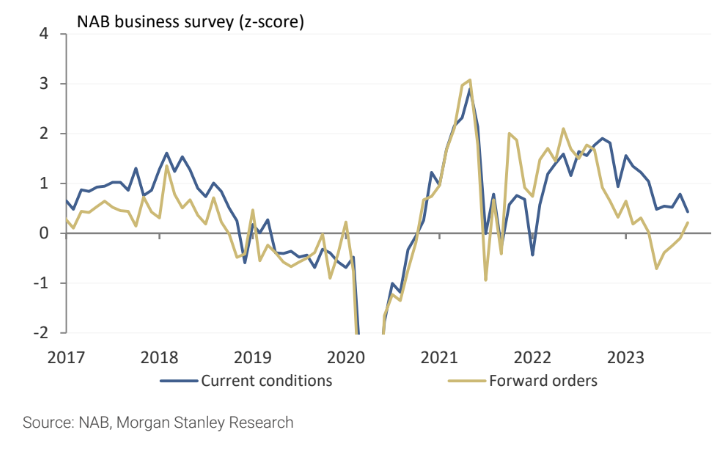
While there is an argument that increasing rates further increases the risk of corporate defaults and prolongs tough business conditions, the uptick in business investment suggests corporate boards are coping well with monetary tightening. This makes the RBA's job easier if it needs to raise interest rates again. And it knows this, too:
"Strong growth in business investment had been underpinned by rapid population growth and high capacity utilisation. Members noted that non-mining business investment had again surprised on the upside in the June quarter, and growth over the first half of 2023 was the highest since 2007 (excluding the COVID-19 pandemic rebound period). Members discussed how deepening the capital stock should, over time, help to lift labour productivity," the RBA's October meeting minutes said.
Reason 4: Housing, housing, and housing
While the RBA never admits to targeting asset prices, it can't ignore what is happening in the housing market. Conventional wisdom suggests that higher interest rates have a big impact on servicing mortgages and an even bigger impact on those who haven't taken out a mortgage yet. But apparently, no one told that to the rental market - with vacancies continuing to crater in the major centres.
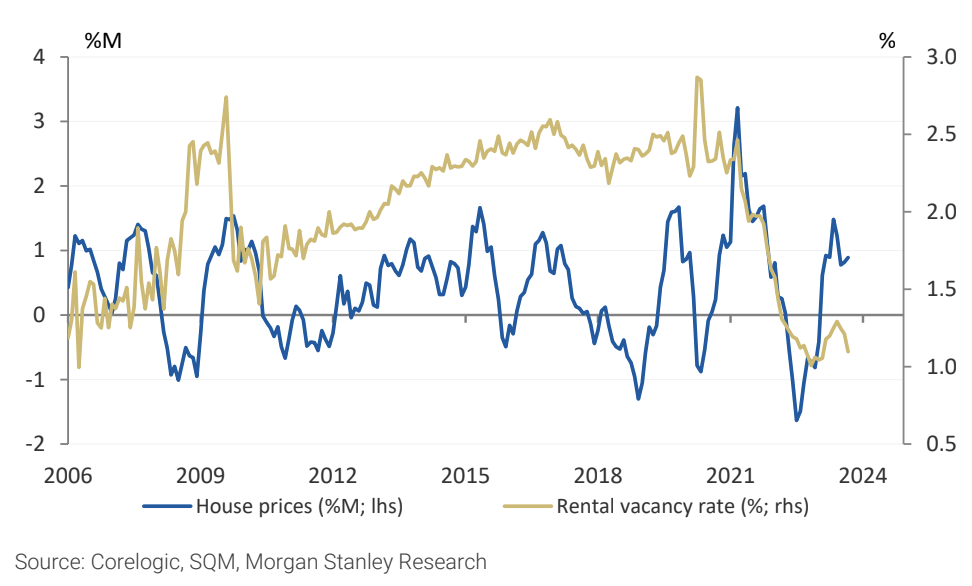
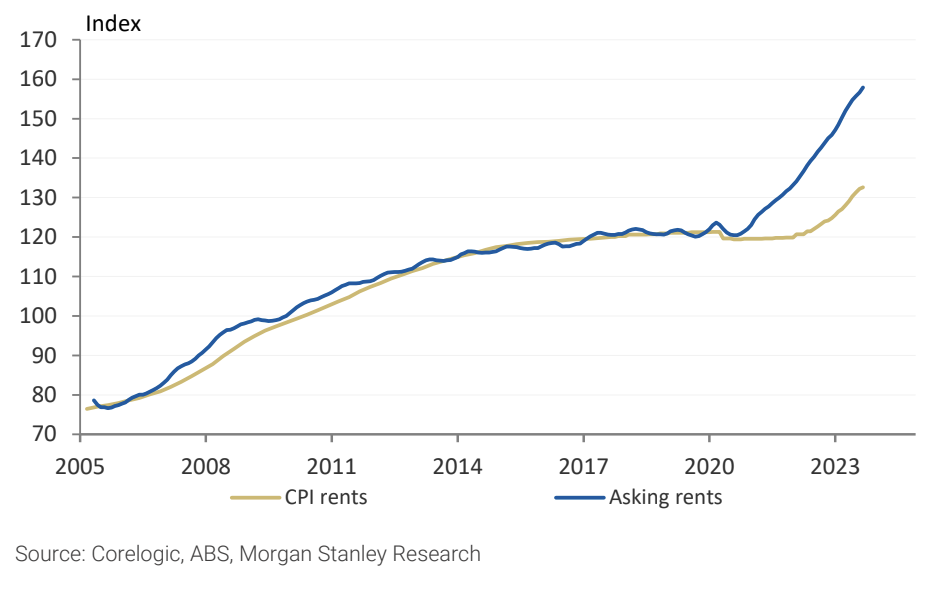
Reason 5: The effect of all these rate hikes on markets and the Australian Dollar is arguably muted
Before inflation and asset prices, central banks target the value of the currency first and foremost. While there has been tough talk on the cash rate from newly-minted Governor Michele Bullock, the Australian Dollar has been rocked by many other external factors - namely a much stronger US Dollar, rising bond yields, and a general flight to safe assets across most markets (the Australian Dollar is widely perceived as both a China proxy and a risk-on currency).
Outside of the GFC and COVID, the Australian Dollar is at levels not seen for more than 20 years. The weaker currency generally boosts exports, cuts trade deficits, and reduces the cost of interest payments on outstanding government debts. If the RBA were to hike interest rates, this would send the Australian dollar higher.
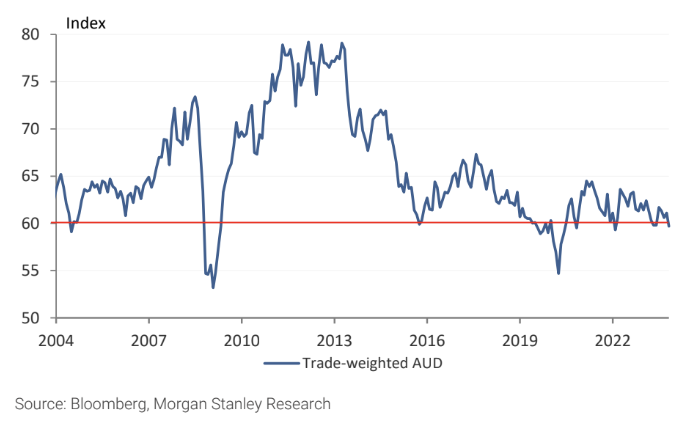
The other place you tend to see the first-round effects of central bank rate hikes outside the currency is in the rates market. Real interest rates, which affect borrowing costs and saving decisions for consumers and businesses alike, remain negative in Australia. That may give the central bank an impetus to keep going and an incentive to say that monetary policy is tight but not restrictive.
For the record, real interest rates are calculated as the nominal rate minus inflation. A negative real rate suggests inflation is higher than the benchmark interest rate.
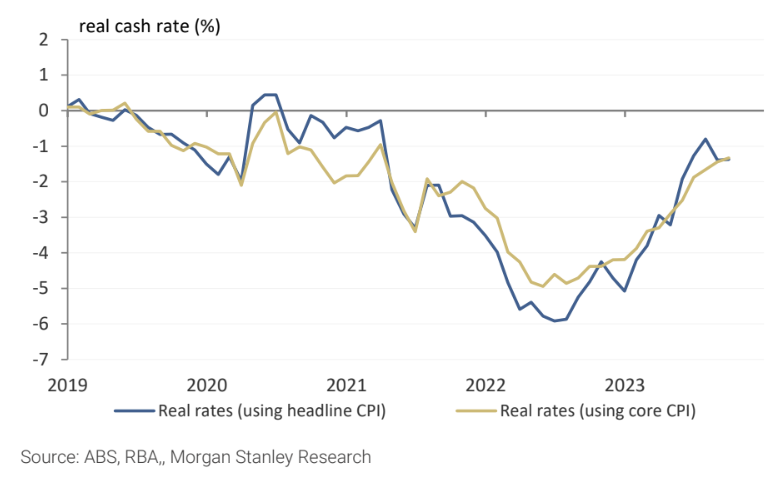
The insider's view
Challenger Chief Economist Jonathan Kearns told me he thinks a rate hike next week is almost a done deal.
"I expect the RBA to increase rates next week. It was a pretty clear statement in their Board minutes and reiterated by the Governor that they have a low tolerance for inflation returning to target more slowly than their most recent forecasts," Kearns said.
"Even accounting for the strong contribution to the quarterly inflation number from fuel, inflation seems to be a bit stronger than the RBA previously anticipated. Given policy is not as tight in Australia as elsewhere, the slightly stronger inflation should be enough to tip the RBA to a rate rise."
As for the case against a rate hike, Kearns said the case was marginal.
"The case against a rate rise is that inflation was only marginally stronger than expected. Most of the overshoot was the result of the higher oil and petrol prices. Oil price shocks are typically taken to be supply shocks, which central banks look through. Also, more information on the persistence of inflation will come with the Wage Price Index data next month," he said.
And as for whether Kearns thinks we are done:
"I think there is a chance of another increase, but it wouldn’t necessarily be in November. It could be in February if inflation proves to be persistent. The path of policy is always data dependent but it’s especially true from here," he said.
One key reason why the RBA won't hike rates
Despite the reasons we've listed above, there are other good reasons why the RBA may elect not to hike interest rates next week. Chief among them, the weakening consumer leading a per capita recession in Australia.
The RBA calculates that 15% of households are earning less than their monthly outgoings. Any increase in the interest rate means more households join that group. Weak retail sales figures from earlier this week would support that view. Nominally, retail sales are up the most in eight months but the downtrend is plain to see.
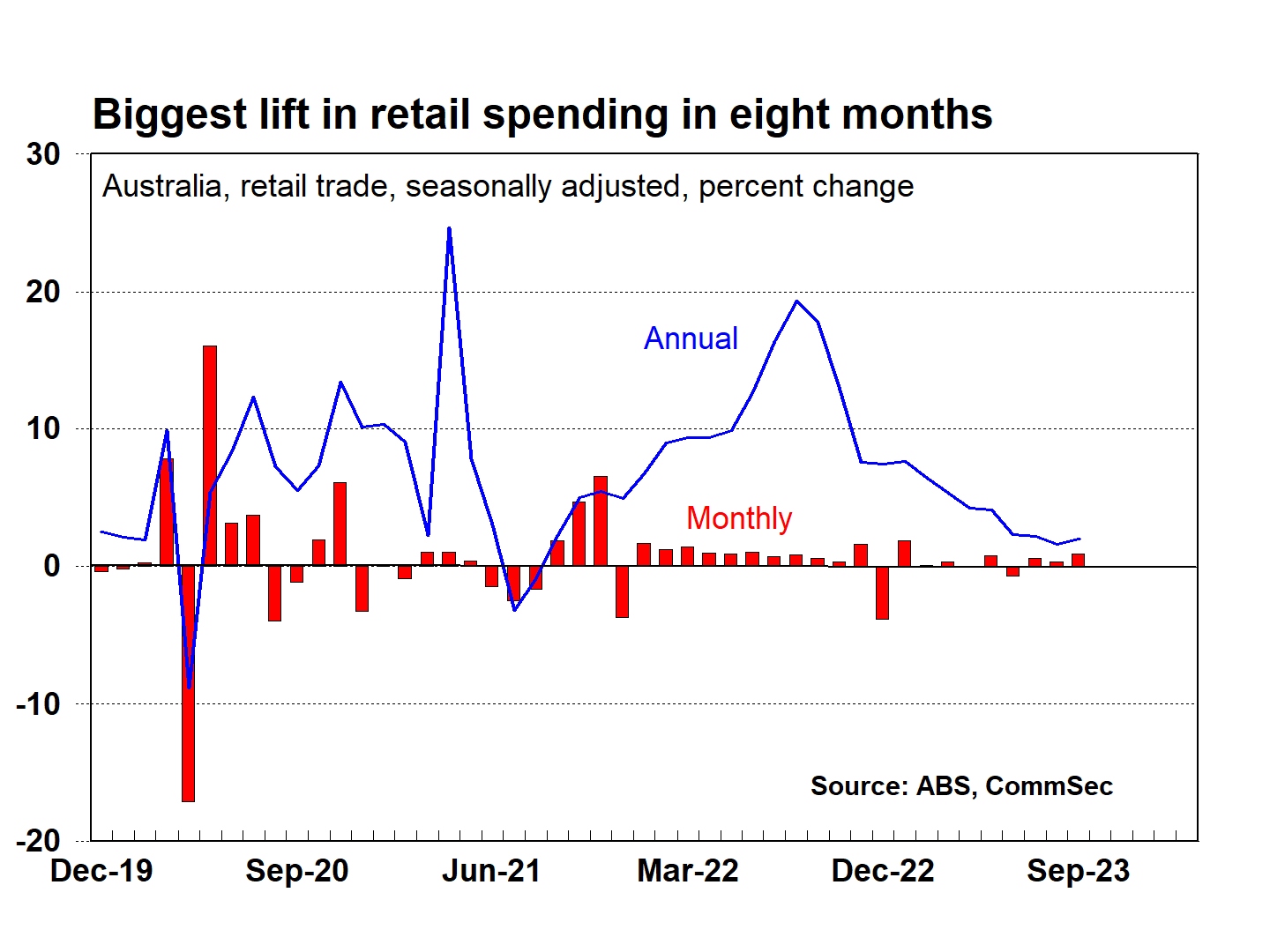
While Australia is not technically in a recession, real GDP fell by 0.3% quarter-on-quarter last month. Put another way, the Australian economy is feeling the brunt of all these rate rises at the individual level. Note, that "individual" in this case, is an average. As is with anything, the less well-off in our society feel the brunt of these rate rises far more than the top end.
There is also an argument for how much increases in the nominal interest rate can really affect the path of inflation.
Deloitte Access Economics, for one, has been pushing for the pause to continue, "even in the face of some nervousness around oil prices and wages edging up," lead economist Stephen Smith wrote.
In July, Smith told Sky News that he thinks the RBA has already gone too far.
How does all this affect equities?
In short, cash rate-sensitive sectors will be taken on another ride.
Morgan Stanley are underweight the Big Banks, REITs, and some consumer names. The model portfolio's main overweights by sector are energy stocks, telecom stocks, and, within financials, the insurance names.
UBS tend to agree with strategist Richard Schellbach recently writing that cyclically-exposed stocks do badly during a "rate plateau" (i.e. higher for longer) rates scenario. With this in mind, the team is long consumer staples, healthcare, and insurance.
And naturally, a rate hike on inflation concerns tends to push down bond yields, although that effect will now be more muted given rates traders have priced in this coming rate hike. A rate hike may also make some short-term cash instruments more attractive (if only temporarily).
4 topics
1 contributor mentioned

